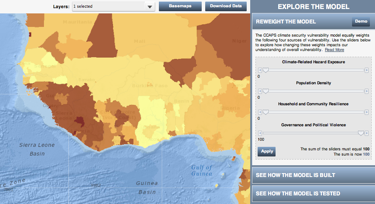The Strauss Center’s Climate Change and African Political Stability (CCAPS) program today released the new CCAPS climate dashboard, an online platform that displays data on physical, socio-economic, demographic, and political insecurities to assess how these factors contribute to “climate security” vulnerability in Africa.
The CCAPS climate dashboard, built in partnership with Development Gateway, a member of the AidData partnership, utilizes the CCAPS Climate Security Vulnerability Model to analyze where and how climate-related events could disrupt Africa’s security and development.
“The climate dashboard allows users to explore pressing climate security risks in a new hands-on way,” said CCAPS senior program manager Ashley Moran. “Leveraging the rigorous modeling of CCAPS researchers, the dashboard allows people to use the model to explore insecurities in Africa and to test their own beliefs about what drives vulnerability to climate change in Africa.”

The CCAPS Climate Dashboard allows users to explore the Climate Security Vulnerability Model, developed by CCAPS researchers to identify the locations of chronic vulnerability to climate security concerns in Africa.
The dashboard shows how the four sources of vulnerability used in the CCAPS model—physical exposure to climate-related hazards, population density, household and community resilience, and governance and political violence—contribute to local areas’ overall vulnerability to climate security concerns.
While the CCAPS model weights each source of vulnerability equally, the interactive features of the dashboard allow users to explore how changing these weights impact the overall understanding of vulnerability.

Users can reweight the four sources of vulnerability included in the CCAPS Climate Security Vulnerability Model. By reweighting the sources of vulnerability, users can explore how each factor, such as governance and political violence shown above, impacts the results of the model.
In addition to reweighting the CCAPS climate security model, users can see how the model is built, learn more about how the model has been tested, and download maps produced by the CCAPS model.
“The CCAPS model offers a nuanced way to assess the security vulnerabilities associated with climate change in Africa and the potential intervention points to build resilience,” said LBJ School associate professor Joshua Busby whose team developed the CCAPS climate security vulnerability model. “We are excited about this new interactive platform that allows researchers and policymakers to engage with the model in a dynamic way.”
CCAPS partnered with Development Gateway to launch its integrated mapping platform in early 2012 to analyze how climate, conflict, and aid intersect. CCAPS and Development Gateway have since produced data dashboards to provide in-depth examination of several thematic areas under study on the CCAPS program. The CCAPS mapping platform is available at www.strausscenter.org/ccaps/mappingtool.